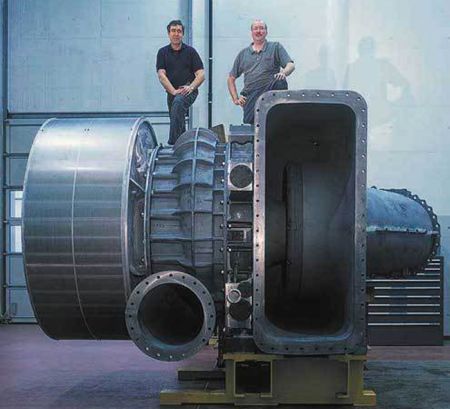
At its most basic level, a turbocharger manages the air in an engine so that the engine will perform as well as it possibly can. The turbocharger ensures that more fuel and air can be forced into the engine, so that the engine can burn more fuel and burn it more efficiently. If a turbocharger compresses the air enough to force 50% more fuel into the engine, you might expect 50% more power, right? But in fact, the fuel-air mixture burns more efficiently at higher pressures, so you get more power more efficiently. That’s the essence of air management.
Whether on land or sea, today’s big rigs simply wouldn’t be what they are now without their turbochargers. Conventional engines would be four times larger if Alfred Büchi hadn’t invented the turbocharger over a century ago. When a turbocharger stops running, its engine loses up to 75% of its power. You can talk all you want about optimizing engine performance with just the right piston design or cylinder shape or whatever else (and engine builders understandably do), but it’s the turbocharger’s management of the air that really makes the difference in an engine’s performance.
The power in a turbocharger isn’t actually the most important measure of a turbocharger. Of course a turbocharger has to be powerful, but what matters most is how much throughput a turbocharger has and what pressure it can reach. These two variables, volume flow and pressure ratio, respectively, raise the air pressure and ensure a lot of air flow in an engine.
These two variables create a high-pressure environment that makes it possible to inject more fuel into the engine, and what happens next is clear. A technician might say that the engine can do work faster; most of the rest of us would probably say that the engine can work harder. But both would agree that the additional fuel allows the engine to put out more power, and that’s the whole point, really.
The turbocharger in the picture is a TPL 91, three of which would fit on a 12K98ME by MAN, an engine that you might see on a large, ocean-going vessel or a diesel power station. The TPL 91 has a pressure ratio 4.25. It is a mammoth turbocharger, no doubt. But times have changed, and our technical teams have learned how to do the thing even better. Now we have a new generation of turbochargers for two-stroke engines, the A200-L, that with its pressure ratio of up to 5.0, even tops the TPL 91. That’s five times the ambient pressure, practically unheard of before for a very large engine. So even though the A200L is in fact compacter, it packs a more powerful punch than the TPL 91.
I’m sure there are other ways to define powerful in a turbocharger, and I’d really love to hear more about what others reading this post think. And I’d still love to know what the individual who posted this photo meant by powerful. Any takers?
We use cookies to improve your experience. By continuing to use our site, you accept our Cookies, Privacy Policy,Terms and Conditions. Close X